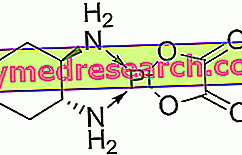Oxaliplatin is an anticancer drug belonging to the class of alkylating agents. It is considered an important drug, so much so that it is included in the list of essential drugs compiled by the World Health Organization; a list that lists all the drugs that must be present within a health care system of
basis.
Indications
For what it uses

Oxaliplatin - Chemical Structure
Oxaliplatin is indicated for the treatment of tumors such as:
- Colon-rectal cancer;
- Lung cancer;
- Stomach cancer;
- Esophagus cancer;
- Bladder cancer;
- Head and neck cancer;
- Ovarian cancer.
Warnings
Oxaliplatin should only be used in specialist oncology wards and under the strict supervision of a doctor who specializes in the administration of anticancer drugs.
Due to the toxicity of oxaliplatin in the kidneys, the renal function of patients being treated with the drug must be constantly monitored.
In case of extravasation of oxaliplatin from the infusion site, the administration should be stopped immediately and local symptomatic treatment should be initiated.
Due to the neurological toxicity of oxaliplatin, a neurological examination must be performed before each administration and, subsequently, checks must be carried out at regular intervals.
Interactions
The administration of oxaliplatin should be avoided together with drugs that increase the pH of the intravenous solution, since oxaliplatin decomposes in a basic environment (pH value between 7 and 14).
Oxaliplatin is often used in combination with 5-fluorouracil . This association could lead to an increased risk of developing pulmonary fibrosis and peripheral sensory neuropathies.
In any case, it is advisable to inform your doctor if you are taking - or if you have recently been - medicines of any kind, including over-the-counter medicines, homeopathic and / or herbal products.
Side effects
Although oxaliplatin is less toxic than its cisplatin and carboplatin analogues, it can also trigger many side effects.
The side effects vary depending on the amount of drug administered, depending on whether the drug is administered alone or in combination with other anticancer agents and depending on the patient's condition. Furthermore, each individual responds differently to chemotherapy, so it is not said that all adverse effects are shown with the same intensity in each patient.
The following are the main side effects induced by oxaliplatin.
Myelosuppression (bone marrow suppression)
Oxaliplatin can suppress bone marrow leading to reduced blood cell synthesis (ie reduced haematopoiesis). The decrease in blood cell production can lead to:
- Anemia (reduced amount of hemoglobin in the blood);
- Leukopenia (reduced number of white blood cells) with consequent increased susceptibility to infection contraction ;
- Plateletopenia (reduced number of platelets) leading to bruising and abnormal bleeding with an increased risk of bleeding .
Gastrointestinal disorders
Oxaliplatin can cause nausea, vomiting and diarrhea .
Vomiting can be kept under control with the use of anti-emetic drugs (antivomito). If the symptom occurs in a severe form - or if it persists despite the use of drugs - it is necessary to inform the doctor.
Diarrhea can be controlled by the use of antidiarrheal drugs. In any case, it is necessary to drink a lot to replenish lost fluids.
In case of severe diarrhea and / or vomiting, problems such as:
- Dehydration;
- Paralytic ileus;
- Intestinal obstruction;
- Hypokalaemia (reduction in blood levels of potassium);
- Metabolic acidosis;
- Renal impairment;
- Pancreatitis (in rare cases).
These adverse effects may occur especially if oxaliplatin is administered in combination with 5-fluorouracil.
Neurological disorders
Oxaliplatin treatment can cause peripheral sensory neuropathy (ie an altered functioning of peripheral nerves in the body) that is not always reversible after the conclusion of therapy and localized paresthesia ; these disorders can persist up to three years after the end of the treatment with the drug.
Other side effects that can occur are headache, dizziness, speech disorders, convulsions and meningism (ie the typical symptoms of meningitis, caused by irritation of the meninges, but in the absence of a real meningitis).
Hair loss
Oxaliplatin therapy can cause hair loss and hair loss in general. Hair and hair can thin out or fall off completely, but this is a temporary side effect. Hair and hair should grow back soon after the end of therapy.
Oral cavity disorders
During therapy with oxaliplatin, small ulcers can occur in the oral cavity with a feeling of pain and dryness . To prevent this side effect many liquids must be taken and regular cleaning of the teeth must be performed using a soft toothbrush, at least two or three times a day.
You can also incur in the temporary alteration or loss of taste that should return to normal shortly after the end of chemotherapy.
Allergic reactions
Oxaliplatin can trigger allergic reactions in sensitive individuals. Symptoms such as rashes accompanied by itching, increased body temperature, chills, localized redness in the face, dizziness, headache and shortness of breath may occur.
These symptoms can occur both mild and severe; if one of them appears, it is necessary to inform the doctor that - if he considers it necessary - he will prescribe a pharmacological treatment.
Laryngeal spasm
Treatment with oxaliplatin may cause a reduction in the sensitivity of the area around the larynx, causing difficulty in swallowing and difficulty breathing. This is a transitory side effect. This effect can be triggered by the cold, therefore we do not recommend the consumption of iced drinks and cold foods for a few days after the treatment.
Eye disorders
Oxaliplatin therapy can cause conjunctivitis, temporary decline in visual acuity, vision loss caused by inflammation of the optic nerve (optic neuritis), temporary and reversible loss of vision.
Ear disorders
The intake of oxaliplatin can cause hearing problems and, in some cases, deafness.
Respiratory system disorders
Oxaliplatin treatment can cause various disorders of the respiratory system, such as dyspnoea, cough, hiccups, chest pain and - in the worst case - pulmonary embolism.
Kidney and urinary tract disorders
Oxaliplatin therapy may cause urination difficulties, pain during urination, haematuria (presence of blood - visible or not - in the urine), frequency of abnormal urination. Abnormal renal function may also occur.
Liver disorders
The intake of oxaliplatin may induce alterations in liver function which must therefore be kept under strict control.
Other side effects
Other side effects that may occur following the intake of oxaliplatin are:
- Low back pain;
- Depression;
- Insomnia;
- Nervousness;
- Weakness and / or fatigue;
- Weight loss;
- Abnormal increase in blood sodium concentration;
- Anorexia;
- Increased thirst;
- Joint and bone pain;
- Epistaxis.
Overdose
There is no antidote for oxaliplatin overdose. The symptoms that are expected after taking an overdose of medication consist of an increase in the intensity of the side effects. If you have taken - or suspect you have taken - an overdose of medication you should immediately inform the oncologist. Pharmacological treatment in the event of overdose is only symptomatic.
Action mechanism
Oxaliplatin belongs to the class of alkylating agents and is able to form bonds with the two strands that make up DNA.
DNA consists of four fundamental units called nitrogenous bases, these molecules are cytosine, thymine, adenine and guanine.
Oxaliplatin performs its cytotoxic action (toxic to cells) forming very strong bonds with a nitrogen atom present in the guanine structure.
The link between the drug and the DNA prevents it from being transcribed and replicated. If the cells are no longer able to divide, then they undergo the mechanism of programmed cell death called apoptosis .
Mode of Use - Posology
Oxaliplatin is available for intravenous administration. It is found in the form of a powder that must be dissolved in a special solvent just before administration.
Oxaliplatin can be administered through three different routes:
- Through a cannula (a thin tube) that is inserted into a vein of an arm or hand;
- Through a central venous catheter that is inserted subcutaneously into a vein near the clavicle;
- Through the PICC line ( Peripherally Inserted Central Catheter ), in this case, the catheter is inserted into a peripheral vein, usually of an arm. This technique is used for the administration of anticancer drugs for a prolonged time.
The dosage must be established by the oncologist according to the type and stage of the cancer to be treated and according to the patient's condition.
The dose of oxaliplatin that is used is usually 0.85 mg / m2 of body surface area.
Pregnancy and breastfeeding
Animal studies have shown reproductive toxicity by oxaliplatin. Consequently, its use in pregnant women is strongly discouraged.
Moreover, during the whole treatment with the drug, precautions must be taken - by both sexes - to avoid possible pregnancies. Since genotoxic effects have also been reported, precautions must be taken even after the end of treatment, for a period of at least six months.
Women taking oxaliplatin should not breast-feed.
Contraindications
The use of oxaliplatin is contraindicated in the following cases:
- Known hypersensitivity to oxaliplatin or other platinum-containing compounds;
- In case of pre-existing myelosuppression;
- Peripheral sensory neuropathy prior to the start of therapy;
- Severe renal impairment;
- Pregnant;
- During breastfeeding.



